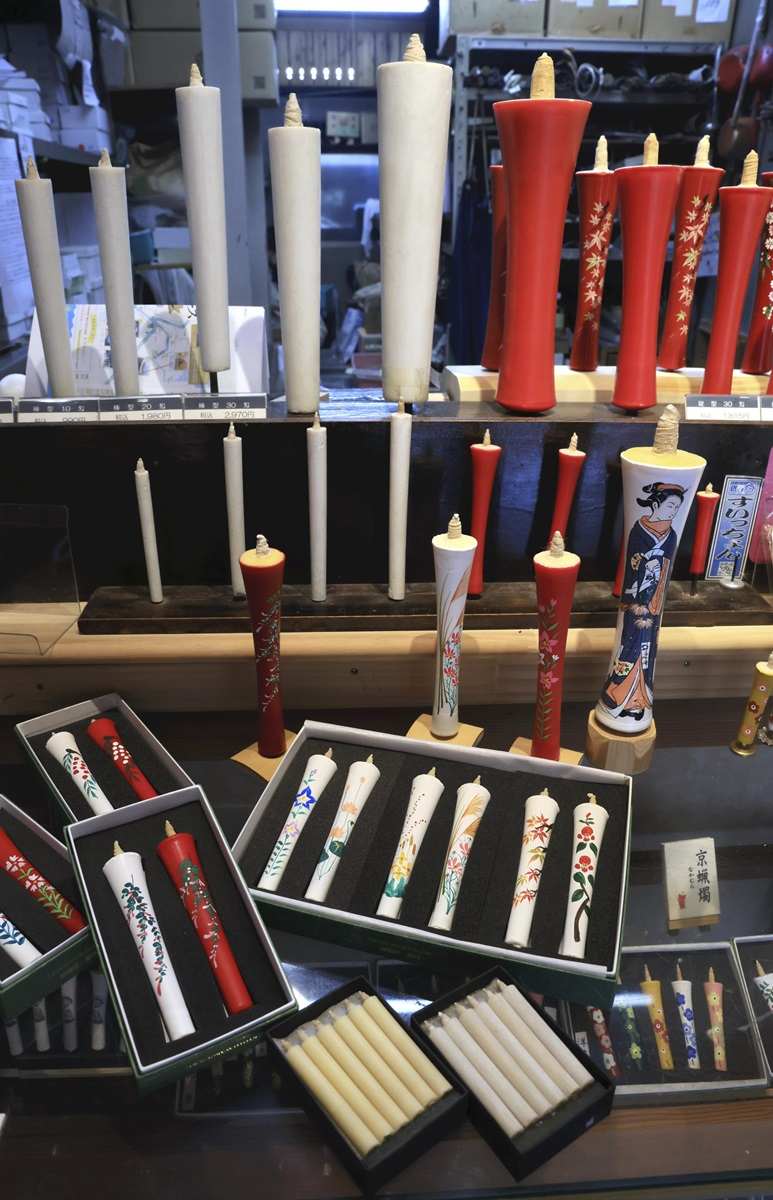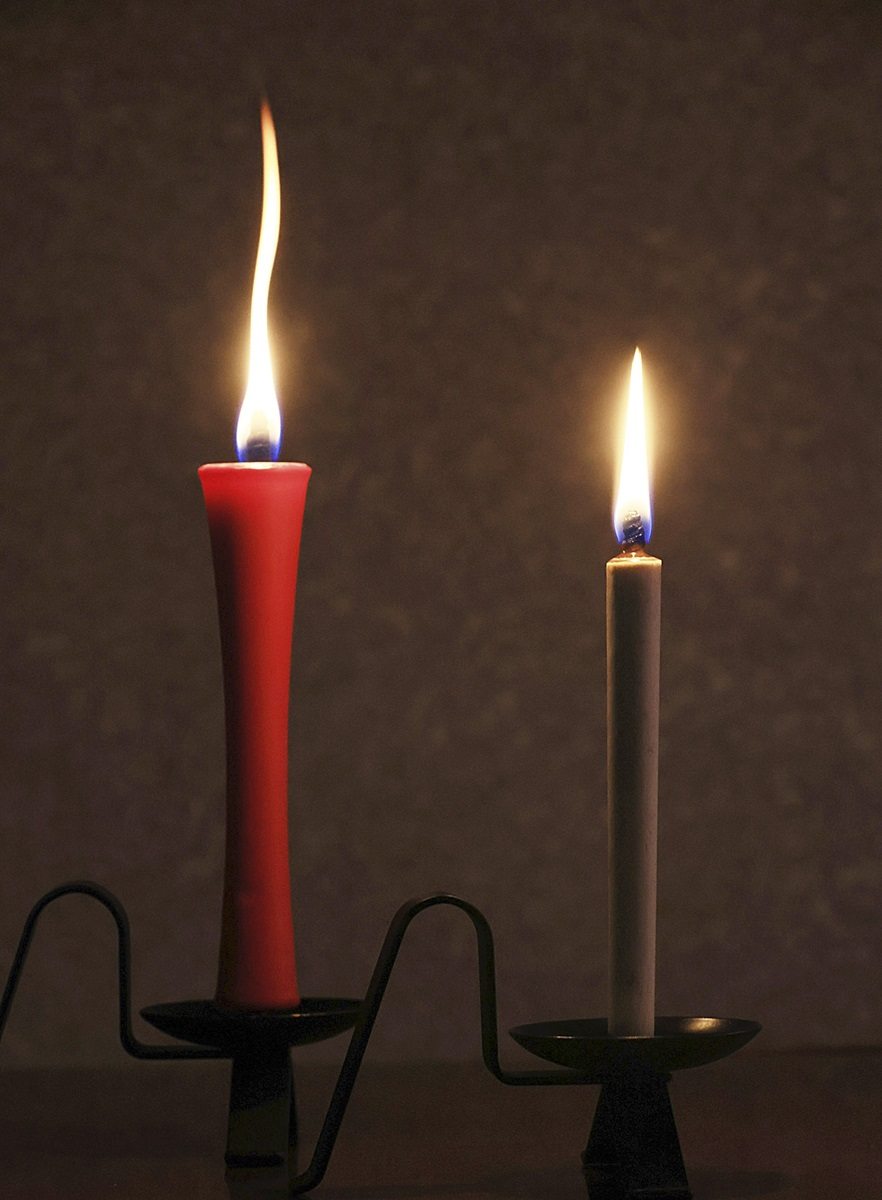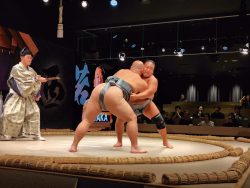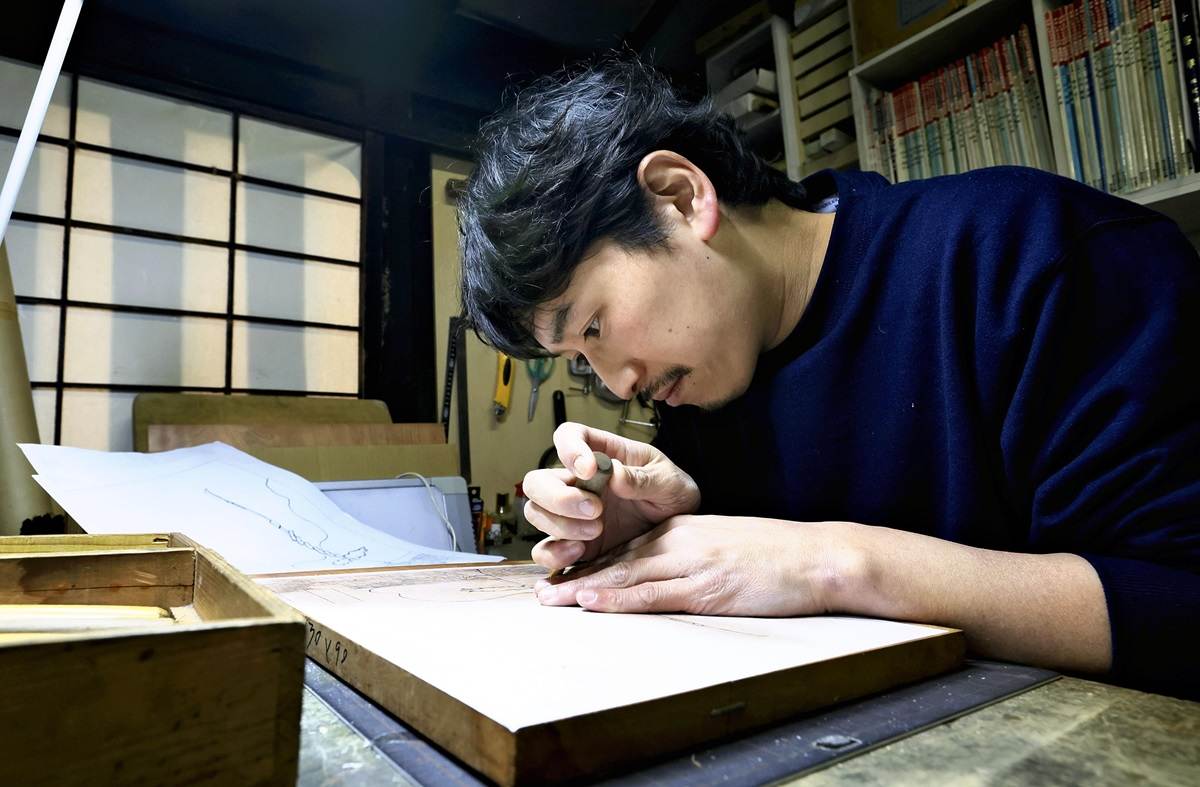
Hirokazu Tagawa covers a candle with red wax in Fushimi Ward, Kyoto.

12:12 JST, October 5, 2024
KYOTO — A candle’s reddish flame faintly, beautifully illuminates the face of a maiko apprentice geisha as she dances in the low light. The flame sways to her dance, and shadows move elegantly across a gold folding screen.
At an event in late August, a maiko danced, softly illuminated by Japanese candles, at a hotel in Kyoto. Hirokazu Tagawa, the Japanese candle craftsman who organized the event, carefully watched from the back of the venue.
Long ago, before electric lights were invented, maiko needed to make their faces shine even under candlelight, which is believed to have led to them putting on white makeup. Reproducing the beauty that Japanese people saw in the past is one of Tagawa’s life works. “Unless we create such opportunities, the essence of traditional culture could be forgotten,” he said.

A maiko dances by candlelight at an event to convey the beauty of Japanese candles.
The production of candles using the fruit of haze wax trees began in the Muromachi period (1336-1573). Since Japanese candles are made from a plant-derived wax, they produce less soot and fewer drips. The hollow core of the wick allows the flame to flicker as if it has a will of its own. Petroleum-derived candles can’t produce this kind of ambience.
Tagawa has been organizing the candlelight dance event for about 10 years, wishing to demonstrate authentic culture, even if only to those who have a deep interest.
Tireless efforts
Tagawa’s shop and factory are in Fushimi Ward, Kyoto. As I passed through the noren curtain, I smelled the aroma of melted wax. Tagawa was working on candle coloring, called shugake in Japanese, the final stage in making Japanese candles.
Picking a thin wooden stick inserted into a candle with his left hand, Tagawa scooped melted red wax from the pot with a ladle in his right hand. He tilted the candle stick a little, rotated it and smoothly covered it with red wax.

Heated wax is applied to dough candles with bare hands
Tagawa previously worked for a major automaker. He quit his job and immersed himself into the world of candle making in 1988 at the age of 25, as his father-in-law became unwell. His father-in-law Ryozo Nakamura was the third president of the candle making and sales shop “Nakamura Rousoku,” founded in 1887.
Tagawa helped his mother-in-law, who ran the shop on behalf of her husband, and the employees every day by watching and imitating what they were doing. Hoping to learn more about candles, he visited more than 10 candlemakers across the country to watch their production process and purchase finished products. Doing so, he was able to deepen his knowledge.

Various kinds of Japanese candles are displayed, including ones with images, which are popular among young people and foreign tourists.
From morning until night, Tagawa kept making candles and improved his techniques. He said he is the type of person who, once he has made up his mind, he does not change it easily. Regardless of whether or not he would take over the shop, he vowed to become a full-fledged candlemaker.
“If we fail to meet demands, Japanese candles will soon be replaced by electric lights or Western candles. I needed to keep working,” he said. When his father-in-law passed away in 2007, Tagawa became the fourth president of the shop.
New initiatives
How can Japanese candles be passed on to future generations? As the president of the company, Tagawa launched a project to give concrete shape to his mission. As the number of farmers growing haze wax trees continues to decline, he began growing the trees and harvesting their fruit in cooperation with local high school students.
The young trees began bearing fruit several years ago, though some were damaged by animals and cold weather. It is still difficult to produce candles exclusively using the fruit they have harvested. However, they have high hopes for the future.

Japanese candle flames sway wildly.
While spending days working through trial and error, Tagawa sometimes makes discoveries that lead to new possibilities for candles.
When he experimented with new ideas during the COVID-19 pandemic, he developed candles for meditation. He came up with the idea of using candles’ feature of being able to adjust their burning time by changing their thickness and length. The candles turned out to be popular among women in their 20s and 30s, as well as foreign tourists visiting Kyoto, for their relaxing effect.
Tagawa posted videos on social media to introduce the production process and the method of extinguishing a candle flame using a tool called a “shinkiri.” He has received many comments such as “This post makes me interested in traditional etiquette” and “The flame looks warm and beautiful.”
“I think that there are people who want Japanese candles. That is why I have to act now,” Tagawa said. His heart is passionate like a candle flame, burning quietly and gracefully.
***
If you are interested in the original Japanese version of this story, click here.
"Features" POPULAR ARTICLE
-

Students Recreate 19th-Century Bento Boxes Made for Ino Tadataka’s Survey Team in Hot Spring Town on Nakasendo Road
-

Santa Claus Delivers Christmas Presents to Penguins at Aquarium in Japan’s Nagasaki Prefecture
-

Sumo Restaurant in Tokyo Teaches Foreign Visitors About the Ancient Sport, with Bouts Between Retired Rikishi
-

Autonomous Passenger Ship Connects Mainland with Remote Island in Seto Inland Sea; World’s 1st Commercially Operated Autonomous Vessel
-

Osaka’s Sumiyoshi Taisha Shrine Bustles with New Year’s Visitors
JN ACCESS RANKING
-

As Chinese Tourists Shun Japan, Hotels and Stores Suffer
-

Osaka-Kansai Expo’s Economic Impact Estimated at ¥3.6 Trillion, Takes Actual Visitor Numbers into Account
-

Japan Govt Adopts Measures to Curb Mega Solar Power Plant Projects Amid Environmental Concerns
-

BOJ Gov. Ueda: Highly Likely Mechanism for Rising Wages, Prices Will Be Maintained
-

Economic Security Panels Debate Supply Chains, Rare Earths; Participants Emphasize Importance of Cooperation Among Allies


































